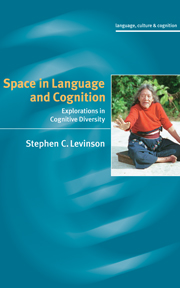Book contents
- Frontmatter
- Contents
- List of figures
- List of tables
- Preface
- Acknowledgements
- 1 The intellectual background: two millennia of Western ideas about spatial thinking
- 2 Frames of reference
- 3 Linguistic diversity
- 4 Absolute minds: glimpses into two cultures
- 5 Diversity in mind: methods and results from a cross-linguistic sample
- 6 Beyond language: frames of reference in wayfinding and pointing
- 7 Language and thought
- Notes
- List of references
- Language index
- Author index
- Subject index
5 - Diversity in mind: methods and results from a cross-linguistic sample
Published online by Cambridge University Press: 03 December 2009
- Frontmatter
- Contents
- List of figures
- List of tables
- Preface
- Acknowledgements
- 1 The intellectual background: two millennia of Western ideas about spatial thinking
- 2 Frames of reference
- 3 Linguistic diversity
- 4 Absolute minds: glimpses into two cultures
- 5 Diversity in mind: methods and results from a cross-linguistic sample
- 6 Beyond language: frames of reference in wayfinding and pointing
- 7 Language and thought
- Notes
- List of references
- Language index
- Author index
- Subject index
Summary
LINGUISTIC INFLUENCES ON THINKING: TESTING THE HYPOTHESIS
In the prior chapter we have seen how spatial description and spatial thinking can co-vary cross-culturally, and we have seen too that there are methods that can be employed to demonstrate this in a non-anecdotal way. In this chapter, we turn to further develop these methods, and then apply them to test the major hypothesis that is at stake in a large cross-cultural sample. Here we will be concerned not with linguistic details, but only with the non-linguistic psychological parameters that seem to correlate with them. The hypothesis in its strongest, crudest form would run as follows:
The frames of reference used in a language constrain or determine the frames of reference used by its speakers in thenon-linguistic coding of spatial scenes.
Many riders are immediately in order. What does ‘used in a language’ mean? We need to note that most languages provide special expressions for more than one frame of reference, and there are conventions for the kinds of circumstances each frame of reference is used in (see, e.g., Tversky 1996). So we need to relativize the statement to situations of use. Second, what does ‘constrain or determine’ mean? The idea behind the hypothesis is that community-wide conventions about what linguistic expressions mean and how they are to be used will tend to induce a way of thinking in which the immediate, unreflective memory coding matches the kind of coding required to describe an arbitrary spatial array.
- Type
- Chapter
- Information
- Space in Language and CognitionExplorations in Cognitive Diversity, pp. 170 - 215Publisher: Cambridge University PressPrint publication year: 2003



